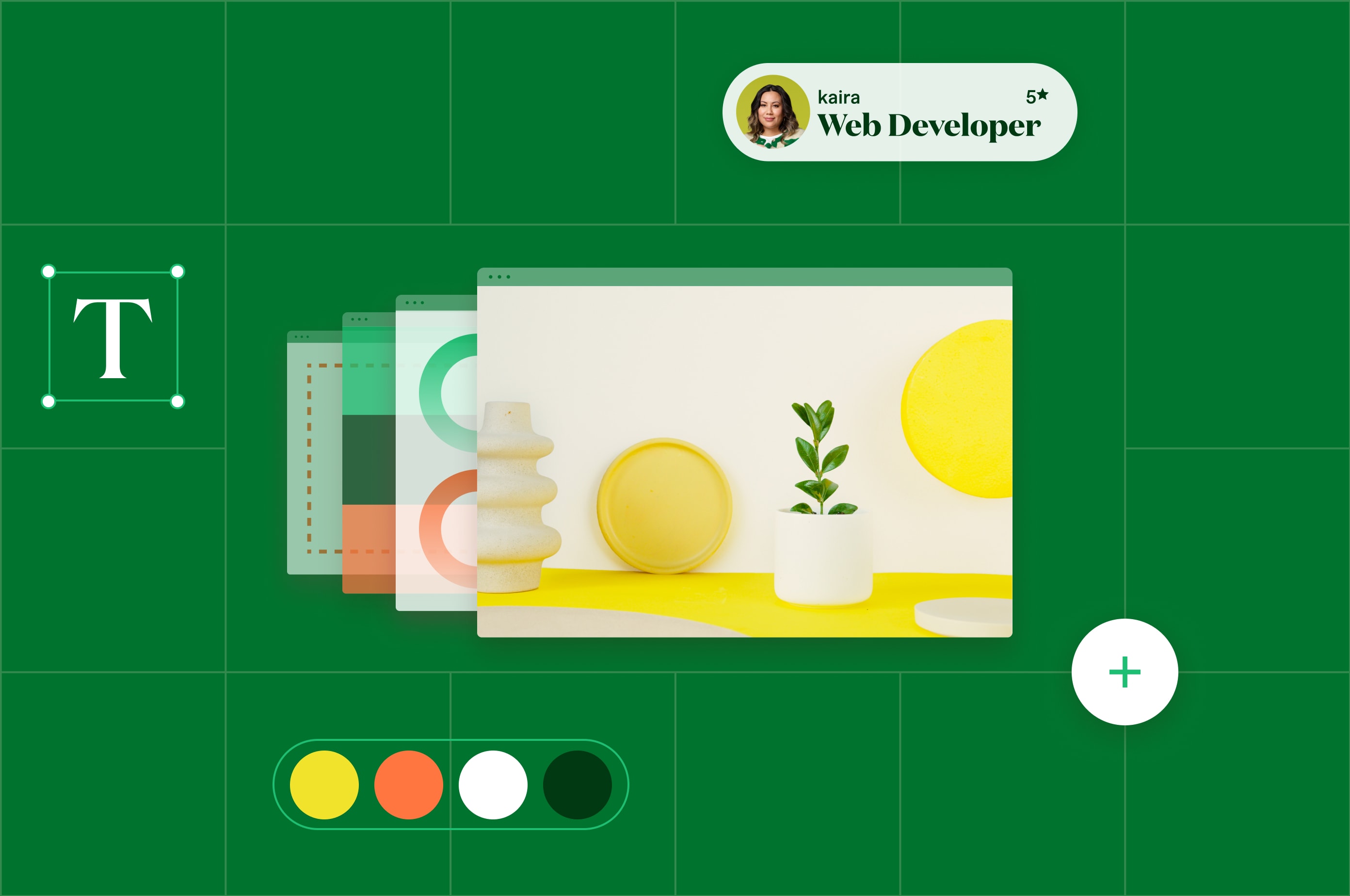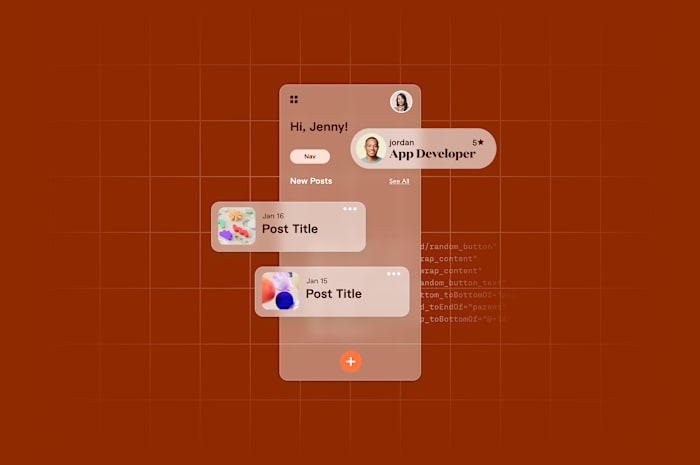How to Create an App Successfully by Following These 10 Steps
A beginner's guide to mobile app development
 June 24, 2024
June 24, 2024 15 minute reading
15 minute reading
This comprehensive guide will walk you through every essential aspect of crafting a successful app. We’ll begin by exploring your idea, then delve into the process of building it and preparing it for download.
Remember, the journey doesn’t end at launch—you’ll need to continuously seek ways to enhance it for a better user experience.
By the end, you’ll know the secrets of standing out from the crowd and taking your app to the next level.
Characteristics of a successful app design
Here are some vital characteristics of a successful app:
User-centric design
Focusing on user needs is essential for any successful app. At its core, an app must solve an actual problem or fulfill a user’s real needs. It should make people’s lives easier, more productive, or more enjoyable. The app must address some pain point or desire the target users genuinely feel.
Providing an intuitive user experience is also paramount. Users should be able to jump in and start using the app immediately, with almost no learning curve. It needs to be smooth and natural to navigate so people can accomplish their goals with minimal steps or frustration.
Proper app development means prioritizing clear information architecture within the app, logical workflows between screens, and a learning process that feels natural. Users want functionality that makes sense right away.
Also crucial is having a clean and visually appealing user interface. Visual design and aesthetics impact user engagement levels. An app developer can choose the best layout and user experience based on your needs.
Clear layouts, intuitive icons, and a harmonious color scheme that create a cohesive brand identity are essential. The interface often makes an app’s first impression, so it needs to look polished and represent the overall user experience.
Technical proficiency
High performance is essential for a positive user experience. If you’ve been researching how to make web apps, you know people want ones that work quickly and smoothly.
This fact is especially true for apps used on older devices. Suppose an app runs just as well on a phone from a few years ago as it does on the latest model. That opens up the potential user base. More users mean more value for everyone involved.
Reliability is also critically important. No one wants to use an app that constantly crashes or experiences bugs. When those issues occur, the relationship between the user and the app developer is damaged. You must recognize testing and quality control when creating an app. Stability and trustworthiness are crucial to retaining those users.
Compelling engagement strategies
Having a robust, unique value proposition is vital. You need to offer something that differentiates your app from others and makes people say, “This is exactly what I’ve been looking for!” Focus on solving a problem or fulfilling a need in a new and better way.
It’s also essential to keep user engagement over time. People want to feel like their apps are constantly improving. Regular updates introducing bug fixes, new features, and security patches show you’re committed to enhancing the experience.
Another important method to connect with your user base is to strategically use push notifications. They can be an excellent way to remind people about your value and encourage return visits. However, the key is making notifications relevant without overwhelming users.
Only send them when you have something beneficial to share. The last thing you want is for people to feel like your notifications are intrusive.
Sustainable monetization
An app needs to be upfront about how it plans to make money. Users need to know what they’re getting into before spending any cash. Whether it’s a free app that offers premium upgrades, a subscription for special perks, or optional extras, people need to understand how the app is monetized so they can decide whether they want to engage with it or not.
Take the freemium model, for example. The basic features are free, so that anyone can try them out. But if you want to unlock advanced tools or remove ads, you pay a few bucks for an upgrade. As long as what users are paying for provides real value and makes the app even better, it’s fair. Users understand the developer needs to earn a living.
Subscriptions are another option. The app may have exclusive communities, tutorials, or content only subscribers can access. Again, as long as the extra perks are quality additions, it makes sense to pay a monthly fee.
Growth and adaptability
You must pay attention to your users’ actions by analyzing user data. App design experts suggest looking at the analytics and data to see what features people use the most or where they’re having problems. That information can help you update the app and improve it over time. It also lets you figure out how to promote the app most effectively.
You must be willing to change as trends and user needs change. Listen to feedback from your users to add new features or improve old ones. Keep yourself updated on new technologies, like augmented reality, and consider how to incorporate them. Be ready to shift your focus if the market wants something different from your app.
How to make an app - Step by Step
Hire a professional app developer on Fiverr
There are endless options in the mobile app market, but only a few rise to the top. So, how do you transform your concept into a thriving app that users adore? Follow these steps:
Step 1: Unearth a winning app idea
Identifying a gap in the market with a business data analysis is a great place to start. Take a look at your daily life and professional experience. Are there any tasks you could streamline, or information that could be easier to access with existing apps? Spotting an opportunity like this allows you to directly come up with ideas that address a current problem or limitation.
When learning how to create a phone app, research current trends in technology, social media, and the interests of your target audience. See if there are any emerging trends that you could leverage uniquely with a new app. Capitalizing on what’s current gets you tapping into topics and themes that people are already interested in.
Remember to analyze popular Android apps and iOS apps similar to what you want to create. What specific features do they have? More importantly, where could your app improve upon to differentiate itself?
Successful existing apps can provide valuable insights into what resonates with users. By combining inspiration from the competition with your fresh take, you can meet user needs in a distinctive way.
Step 2: Define your target audience
Understanding your ideal market is essential for building an app that people want to use. The initial step is defining who your target audience is and creating a buyer persona. Here are some critical components to consider:
Demographics - Get a clear picture of who your "average" user is. Factors like age come into play: Are you aiming for teenagers or baby boomers? Also, think about gender, since that can influence interests. Where people live makes a difference, too. A city-based app probably won’t work well in rural areas. Even income levels are a factor if your app has paid features.
User technology comfort level - The next step in creating a phone app is to consider the users’ tech comfort level. Are these first-time smartphone owners who need simple designs? Or are they a younger crowd who downloads the latest apps right away? Their familiarity with technology will guide how complex or simple your interface needs to be.
User interests - Think about your target users’ motivations and interests. Why do they want an app like yours in the first place? Aligning your app’s features and theme around what drives your target users can boost their enjoyment and engagement over time.
Step 3: Craft a compelling value proposition
To create your app's value proposition, focus on the benefits it provides to users—don’t just list features. People don’t necessarily care about what your app can do on a technical level—they want to know what’s in it for them.
How will using your app make their lives easier or better in some way? Be specific about the problems it solves or the experiences it creates.
While you’re at it, you’ll also want to highlight what makes your app unique, then create a brand identity for your app that’s memorable.
What sets it apart from similar apps already out there? What can your app do that others can’t? Zoom in on your unique selling points to grab people’s attention. If you create an app that doesn’t offer a distinctive value, it will be tough to stand out.
Step 4: Design a user-friendly app
UX design involves the steps users take during their journey within the app, ensuring meaningful interactions at every stage. Meanwhile, UI design focuses on the interaction between users and the app interface, guiding their experience.
A good UX and UI are crucial for an app’s success. Here’s what to consider when designing it:
Focus on your users - What do they need the app to do? Make those tasks easy to complete. Also, consider making the interface as intuitive as possible.
Concentrate on usability - Everything someone does within the app needs to be precise and effortless. Avoid confusing or complex navigation that would frustrate users.
Keep things visually consistent - Use the same colors, fonts, icons, and layout patterns throughout your app development. Having that consistency establishes an excellent design style that users will recognize.
Step 5: Choose the right development path
There are a few different ways to create an app. For example, do-it-yourself app builders let you drag and drop to create essential apps without coding. They’re handy if you want to do something simple and don’t have programming skills.
There are also different approaches to app development:
Native apps: Native apps can be equipped with sophisticated features but must be programmed for one operating system only. They're powerful but lack the versatility of a web app to work across many platforms.
Web apps: A web-based app is a computer program that uses web technology to deliver content and perform tasks. The "brain" behind the app lives on a remote server, so the app only needs some code on the smartphone it’s installed on.
Hybrid or cross platform apps: These combine web and native app design. They are built with a single codebase that the app accesses via remote server. They can also directly access a portable device's operating system, potentially incorporating a wider array of sophisticated functions than a simple web app.
Another option is hiring freelance developers individually. Freelancers are flexible in terms of costs and the experience levels you can find. However, managing multiple freelancers working separately can get quite tricky.
The other choice is partnering with an app development agency. These companies have whole teams of pros who can handle developing your app from start to finish. It takes the management work off your plate, and you get the experience of an entire team working on the app together.
🧠 Learn: 16 Node.js Frameworks for Business App Development in 2024
Step 6: Create a Minimum Viable Product (MVP)
A minimum viable product is a basic version of your app with the core features and functions working. It’s a partial version, but it lets people start using it immediately.
One big reason for releasing an MVP is to get early feedback from people. Launching your MVP to a small group of testers or early users will let you know what’s working well and what needs improvement.
It also lets you test your product assumptions about what users want and need from the app. It should provide ideas about creating an app when you start developing it.
An MVP lets you see if your assumptions are correct by getting your app in people’s hands early. You can find out if people need and want what you thought they would. It validates that your app solves real problems and that people will want to use it.
Finally, it means you can iterate the app quickly based on feedback. Rather than developing the whole thing from start to finish before anyone sees it, you can make changes and release updates to fix issues or add new features based on feedback.
Step 7: Launch and market your app
Submit your app to the appropriate app store (e.g., Apple App Store for iOS or Google Play Store for Android). Once approved, you can set a release date and make the app available to users.
Once you launch your app, it’s time to get people using it. Here are a couple of things you can do:
Optimize your app store listing - Include relevant keywords that people will search for. Spice it up with some eye-catching screenshots and videos, too. The more discoverable you are, the more downloads you’ll get.
Utilize social media - Get on platforms like Facebook, X, and Instagram—anywhere your target users hang out. Build some hype for your launch with an effective social media marketing strategy. Share fun updates and get people excited to download it.
Step 8: Gather user feedback and continuously improve
Don’t rest on your laurels yet—your work is far from over. Now that your app is available, you’ll need to work on improving and upgrading it.
There are some key ways to find out what improvements need to be made.
Implement in app feedback. Make it easy for users to give you feedback in the app. Add quick surveys, a comments section, or prompts to rate the app. That way, feedback will be fresh on their minds.
Monitor app store reviews. Read them closely, spot common problems or requests, and listen to people’s opinions.
Talk to users directly. Reach out to different people and ask about their experiences. Go deeper than reviews. Find out what they think and why.
Track how people use your app. This information can help you in improving your app development strategies. Analytics can show what’s working well and where the experience could improve. Look at downloads, how long people use it, and what they click on.
Step 9: Choose a monetization path
Now that you’ve built up a solid user base for your app, it’s time to start thinking about how to keep the money coming in to fund future developments. Here are a few popular options to consider:
Freemium (free version with upgrades) - Freemium is a smart choice you can use to offer the basic features for free and charge a small fee to “unlock” things like new tools, ad-free mode, or cloud storage. People love a good upgrade.
One-time purchase - As you learn how to make money creating an app, you’ll understand that some people are happy to pay a few bucks upfront. They’re glad to do this if it means not dealing with ads or subscriptions later. It might work well if your app solves problems for a niche group.
Ads that add value - Showing targeted promotions can generate steady income without frustrating users. The key is to only offer ads that help people, not interrupt their actions.
No matter which path you choose, focus on providing value first. The money will follow. Remember—it’s a journey, so have fun experimenting to see what works best for your app and its community.
Step 10: Embrace agility and stay ahead of the curve
Here are a few things to do to improve your app development process.
Always watch what’s hot in tech, follow what people are into, see how people use their phones, and track what’s happening in your business area. You have to know the latest ecommerce trends dominating the market.
Security is also super important these days. Ensure you have strong protections for people’s information so they can feel good about using your app and trust you.
Feel free to try new technologies like artificial intelligence, and virtual or augmented reality. See how they could make your app even better and more fun. You have to keep improving the experience.
Finally, as you continue learning how to make apps, look at all the data you collect. Use it to optimize your app and its promotion. Ensure you’re always learning from what people do to improve it.
Build a successful app with Fiverr
Your app idea is not only brilliant, it’s a potential game-changer. And it doesn’t have to be a roadblock if you lack the technical expertise to turn it into a reality. This step-by-step guide is your gateway to creating an app successfully, inspiring you to take the first step toward your app’s success.
With its convenient and efficient services, Fiverr can be your bridge to success. This vast online marketplace connects you with a global pool of skilled freelance developers who can materialize your vision, relieving you of the technical burden.
So, if coding isn’t your forte, don’t be discouraged. Fiverr, with its high-quality app development services at competitive rates, is here to help.
As a final reminder, always keep your users in mind. Make it user-friendly and build an app that adds value to your target audience. Find the right tools, and do a lot of research. Don’t forget to make the best value proposition to lead you in the right direction.
How to build an app FAQ
How do you ensure your app stands out in a crowded market?
To ensure your app stands out in a cutthroat competition, focus on the following:
Conduct market research, understand your competitors, and identify gaps in the market.
Create a unique value proposition. Ensure that you highlight what sets your app apart.
Develop a strong marketing plan, and then promote your app through various channels, such as social media.
Ensure user engagement. Experts who know how to create an app on the app store stress its importance. So, continuously gather feedback and improve the app to keep users engaged.
What key performance indicators (KPIs) can measure app success?
Key performance indicators (KPIs) for measuring app success include:
Active users: This refers to the number of users actively using the app.
Cost per acquisition (CPA): The cost of acquiring a new user.
Cost per install (CPI): The cost of installing the app.
Cost per mille (CPM): The cost per thousand impressions.
Click-through rate: The percentage of users who click on the app’s ads.
How do you ensure your app meets user needs and expectations?
Great apps solve real problems for real people. Here are essential practices on how to make an app that meets user needs:
Develop user personas to get inside the heads of your target audience. These detailed profiles will help you understand their needs, wants, and pain points, allowing you to tailor your app perfectly.
Take your time with the launch! Test your app with real users throughout the development process. Observe how they interact with it, gather their feedback, and use it to identify areas for improvement before you invest heavily in a final product.
Where can I get reviews?
Feedback is a gift! Make it easy for users to provide input after launch. People studying how to create an app highlight the importance of user feedback. Use surveys, in-app feedback options, or social media to gather valuable insights. Then, incorporate this feedback into future updates to keep your app user-centric.






